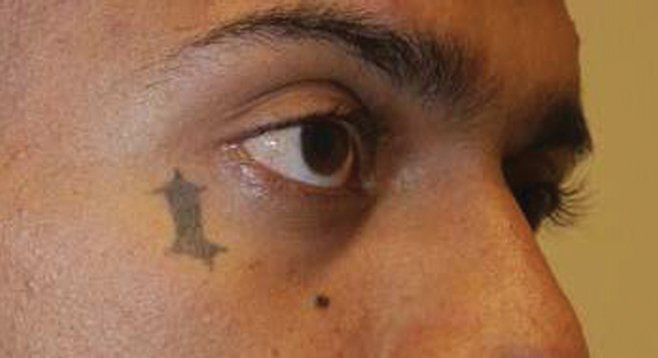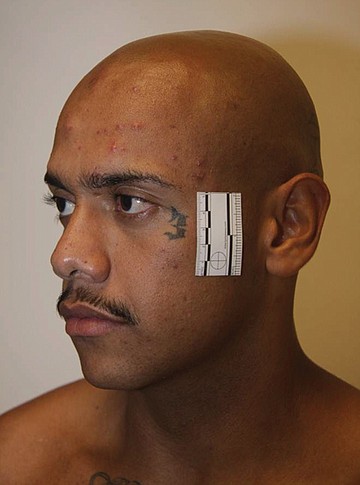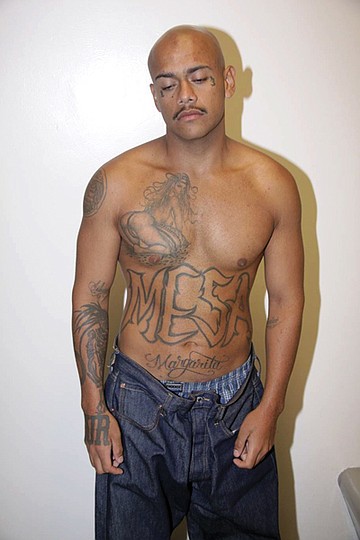 Facebook
Facebook
 X
X
 Instagram
Instagram
 TikTok
TikTok
 Youtube
Youtube

Three people left their Carlsbad home on a cool October evening in 2011 to take the dog for a walk. They all got shot. It was completely dark when David, Erik, and Alejandra left the house at about 8:00 p.m., but their residential street was lit by tall street lamps. David, a pharmacy technician and 15-year Carlsbad resident, had barely walked out of the driveway when a dark car pulled up and a man got out. “He looked directly at me and asked me where we were from,” David said later.
Though not a gang member, 26-year-old David said he knew that he’d just heard a gang challenge. “I said, ‘I’m from nowhere.’ I didn’t want to say anything else. I just stared at him dumbly.” David could see tattoos on his questioner’s face and a blue bandana around his neck.
Erik had already crossed the street with the dog, but he walked back toward the stranger who had stopped. He assumed the man was asking directions.
“Erik came up and he said, ‘What’s up, man?’” David remembered, “He didn’t realize it was a hostile situation at that point.” The gangster repeated his challenge. Erik replied, “We don’t bang.” The gangster then demanded, “What you got on you?” Now it sounded like a robbery. Erik said, “I got nothing. We’re going for a walk.”
The gangster answered, “Oh, yeah?” and pulled a handgun from his waistband.
Erik caught the first four bullets. David got one. Alejandra was struck by one bullet. Carlsbad police never recovered a weapon. They speculated the gun was probably a revolver because they didn’t find any spent cartridges in the street.
All three victims survived to testify at trial one year later.
In October 2012, Luciano Velasquez was charged with three attempted murders. He was 24 when the trial began in the North County Superior Court in Vista. He admitted to being a gang member but denied shooting David, Alejandra, and Erik.


His defense attorney said Luciano Velasquez only has one relative, a sister living somewhere in Mexico whom he has not seen for 20 years. The defender said Velasquez grew up in foster homes.
Prosecutor Geoff Allard said that Luciano Velasquez was raised by a gang.
Velasquez’s gang name is “Vago” which means “lazy.” He belongs to the Varrio Mesa Locos, one of many gangs in Oceanside. Their graffiti and tattoos often read VMLS or MESA. Velasquez has several tattoos, including one large MESA tattooed across the back of his head and another across his belly. There are three dots tattooed on his hand, the dots stand for “mi vida loca” or “my crazy life,” according to police.
Of particular note are the tattoos on his face, because the shooting victims all said they saw tattoos on the face of their attacker. Velasquez has the number 1 tattooed near one eye and the number 3 at the other eye. The number 13 stands for the 13th letter of the alphabet, M; this might refer to the Mesa gang or the Mexican Mafia.
At the time of the shooting, Velasquez was 23 years old, fresh out of prison, and anxious to prove his worth to the Mexican Mafia, according to a prosecutor. “Vago” was released from custody on October 5, 2011, and the triple shooting happened on October 10, 2011.
Velasquez’s prior convictions included being under the influence of meth, possession of drugs for sale, and resisting arrest.
According to the prosecutor, Velasquez left his home turf in Oceanside to invade the heart of Carlsbad gang territory that night. The “barrio” area in Carlsbad is described as “more densely populated” by local police. It’s an awkward mish-mash where one can find a million-dollar home right next to a “shanty,” they say. This barrio is claimed by the Carlos Malos gang. The police map of this barrio shows these boundaries: Carlsbad Village Drive on the north edge, Tamarack Way to the south, the railroad tracks to the west, and Interstate 5 is the east boundary.
During trial, Velasquez startled people in the courtroom when he rose from the defense table and took off his shirt. He seemed pleased to show the jury his large tattoo, “SURENO,” across his back and shoulders. There is a crown atop the “N.” Sureño means “southerner”; it refers to a gangster from Southern California who gets his orders from the Mexican Mafia.
Velasquez’s attorney, Pamela Lasher, built a defense around the Sureño tattoo. Her contention was that a prison-hardened Mexican Mafia soldier would never shoot at three innocent persons out walking their dog. She had her own gang expert, Dennis Bammann, testify for the jury. Bammann said he used to work for the California Department of Corrections, and more recently he is a “private investigator.” He declared it would be “absurd” for a Sureño to attack these three innocents. He claimed the Mexican Mafia does not want to hurt innocents or women or children in gang violence, because they are trying to protect their own families while they are in prison.
The defense called an ophthalmalogist as a witness. This doctor said he studied the defendant’s medical records from prison and gave his opinion that Velasquez was terribly near-sighted and even “legally blind.”
Prosecutor Geoff Allard told the jury, “He’s not legally blind enough to not know he was shooting at people.” The prosecutor added, “Everybody got shot.”
Jurors later said they spent hours discussing the defendant’s tattoos because the shooting victims all described tattoos on their attacker’s face but weren’t quite sure what those markings were. The jurors deliberated almost two full days, and then declared Velasquez guilty of three attempted murders. He could face 75 years to life in prison.
His sentencing is set for February 1. ■


Three people left their Carlsbad home on a cool October evening in 2011 to take the dog for a walk. They all got shot. It was completely dark when David, Erik, and Alejandra left the house at about 8:00 p.m., but their residential street was lit by tall street lamps. David, a pharmacy technician and 15-year Carlsbad resident, had barely walked out of the driveway when a dark car pulled up and a man got out. “He looked directly at me and asked me where we were from,” David said later.
Though not a gang member, 26-year-old David said he knew that he’d just heard a gang challenge. “I said, ‘I’m from nowhere.’ I didn’t want to say anything else. I just stared at him dumbly.” David could see tattoos on his questioner’s face and a blue bandana around his neck.
Erik had already crossed the street with the dog, but he walked back toward the stranger who had stopped. He assumed the man was asking directions.
“Erik came up and he said, ‘What’s up, man?’” David remembered, “He didn’t realize it was a hostile situation at that point.” The gangster repeated his challenge. Erik replied, “We don’t bang.” The gangster then demanded, “What you got on you?” Now it sounded like a robbery. Erik said, “I got nothing. We’re going for a walk.”
The gangster answered, “Oh, yeah?” and pulled a handgun from his waistband.
Erik caught the first four bullets. David got one. Alejandra was struck by one bullet. Carlsbad police never recovered a weapon. They speculated the gun was probably a revolver because they didn’t find any spent cartridges in the street.
All three victims survived to testify at trial one year later.
In October 2012, Luciano Velasquez was charged with three attempted murders. He was 24 when the trial began in the North County Superior Court in Vista. He admitted to being a gang member but denied shooting David, Alejandra, and Erik.


His defense attorney said Luciano Velasquez only has one relative, a sister living somewhere in Mexico whom he has not seen for 20 years. The defender said Velasquez grew up in foster homes.
Prosecutor Geoff Allard said that Luciano Velasquez was raised by a gang.
Velasquez’s gang name is “Vago” which means “lazy.” He belongs to the Varrio Mesa Locos, one of many gangs in Oceanside. Their graffiti and tattoos often read VMLS or MESA. Velasquez has several tattoos, including one large MESA tattooed across the back of his head and another across his belly. There are three dots tattooed on his hand, the dots stand for “mi vida loca” or “my crazy life,” according to police.
Of particular note are the tattoos on his face, because the shooting victims all said they saw tattoos on the face of their attacker. Velasquez has the number 1 tattooed near one eye and the number 3 at the other eye. The number 13 stands for the 13th letter of the alphabet, M; this might refer to the Mesa gang or the Mexican Mafia.
At the time of the shooting, Velasquez was 23 years old, fresh out of prison, and anxious to prove his worth to the Mexican Mafia, according to a prosecutor. “Vago” was released from custody on October 5, 2011, and the triple shooting happened on October 10, 2011.
Velasquez’s prior convictions included being under the influence of meth, possession of drugs for sale, and resisting arrest.
According to the prosecutor, Velasquez left his home turf in Oceanside to invade the heart of Carlsbad gang territory that night. The “barrio” area in Carlsbad is described as “more densely populated” by local police. It’s an awkward mish-mash where one can find a million-dollar home right next to a “shanty,” they say. This barrio is claimed by the Carlos Malos gang. The police map of this barrio shows these boundaries: Carlsbad Village Drive on the north edge, Tamarack Way to the south, the railroad tracks to the west, and Interstate 5 is the east boundary.
During trial, Velasquez startled people in the courtroom when he rose from the defense table and took off his shirt. He seemed pleased to show the jury his large tattoo, “SURENO,” across his back and shoulders. There is a crown atop the “N.” Sureño means “southerner”; it refers to a gangster from Southern California who gets his orders from the Mexican Mafia.
Velasquez’s attorney, Pamela Lasher, built a defense around the Sureño tattoo. Her contention was that a prison-hardened Mexican Mafia soldier would never shoot at three innocent persons out walking their dog. She had her own gang expert, Dennis Bammann, testify for the jury. Bammann said he used to work for the California Department of Corrections, and more recently he is a “private investigator.” He declared it would be “absurd” for a Sureño to attack these three innocents. He claimed the Mexican Mafia does not want to hurt innocents or women or children in gang violence, because they are trying to protect their own families while they are in prison.
The defense called an ophthalmalogist as a witness. This doctor said he studied the defendant’s medical records from prison and gave his opinion that Velasquez was terribly near-sighted and even “legally blind.”
Prosecutor Geoff Allard told the jury, “He’s not legally blind enough to not know he was shooting at people.” The prosecutor added, “Everybody got shot.”
Jurors later said they spent hours discussing the defendant’s tattoos because the shooting victims all described tattoos on their attacker’s face but weren’t quite sure what those markings were. The jurors deliberated almost two full days, and then declared Velasquez guilty of three attempted murders. He could face 75 years to life in prison.
His sentencing is set for February 1. ■
Comments